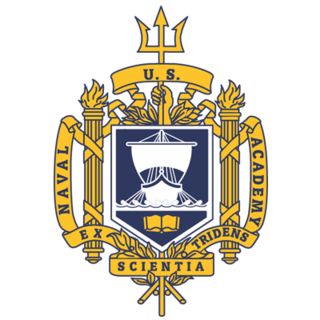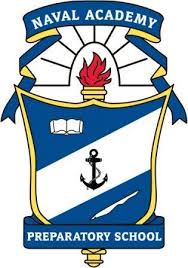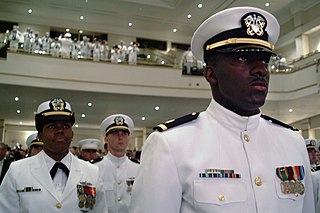
The United States Naval Academy is a federal service academy in Annapolis, Maryland. It was established on 10 October 1845 during the tenure of George Bancroft as Secretary of the Navy. The Naval Academy is the second oldest of the five U.S. service academies and it educates midshipmen for service in the officer corps of the United States Navy and United States Marine Corps. The 338-acre (137 ha) campus is located on the former grounds of Fort Severn at the confluence of the Severn River and Chesapeake Bay in Anne Arundel County, 33 miles (53 km) east of Washington, D.C., and 26 miles (42 km) southeast of Baltimore. The entire campus is a National Historic Landmark and home to many historic sites, buildings, and monuments. It replaced Philadelphia Naval Asylum, in Philadelphia, that served as the first United States Naval Academy from 1838 to 1845, when the Naval Academy formed in Annapolis.
A midshipman is an officer of the lowest rank, in the Royal Navy, United States Navy, and many Commonwealth navies. Commonwealth countries which use the rank include Canada, Australia, Bangladesh, Namibia, New Zealand, South Africa, India, Pakistan, Singapore, Sri Lanka, and Kenya.
The United States service academies, also known as the United States military academies, are federal academies for the undergraduate education and training of commissioned officers for the United States Armed Forces.

The United States Merchant Marine Academy is a United States service academy in Kings Point, New York. It trains its midshipmen to serve as officers in the United States Merchant Marine, branches of the United States Armed Forces and the transportation industry. Midshipmen are trained in different fields such as marine engineering, navigation, ship's administration, maritime law, personnel management, international law, customs, and many other subjects important to the task of running a large ship.
A petty officer (PO) is a non-commissioned officer in many navies and is given the NATO rank denotation OR-5 or OR-6. In many nations, they are typically equal to a sergeant in comparison to other military branches. Often they may be superior to a seaman, and subordinate to more senior non-commissioned officers, such as a chief petty officers.
Officer Cadet is a rank held by military cadets during their training to become commissioned officers. In the United Kingdom, the rank is also used by members of University Royal Naval Units, University Officer Training Corps and University Air Squadron; however, these are not trainee officers with many not choosing a career in the armed forces.
Sub-lieutenant is a junior military officer rank.

The Naval Academy Preparatory School or NAPS is the preparatory school for the United States Naval Academy. NAPS is located on Naval Station Newport, Rhode Island. The mission of the Naval Academy Preparatory School is "To enhance Midshipman Candidates' moral, mental, and physical foundations to prepare them for success at the United States Naval Academy".
Texas A&M University at Galveston (TAMUG) is an ocean-oriented branch campus of Texas A&M University offering both undergraduate and graduate degrees that are awarded from Texas A&M University in College Station. Students enrolled at Texas A&M University at Galveston, known affectionately as 'Sea Aggies', share the benefits of students attending Texas A&M University (TAMU) campus in College Station. TAMUG is located on Pelican Island, offering benefits for its maritime focused majors.
Henry A. Clemson was an officer in the United States Navy in the early 19th century.

The Naval Reserve Officers Training Corps (NROTC) program is a college-based, commissioned officer training program of the United States Navy and the United States Marine Corps.
Pay grades are used by the eight uniformed services of the United States to determine wages and benefits based on the corresponding military rank of a member of the services. While different ranks may be used among the eight uniformed services, pay grades are uniform and equivalent between the services and can be used to quickly determine seniority among a group of members from different services. They are also essential when determining a member's entitlements such as basic pay and allowances.

Douglas Legate Howard was a football player and coach and officer in the United States Navy. He served as the commander of three destroyers during World War I and later as the division commander of destroyers with command of the fleet flagship, the USS Seattle.

Induction Day or I-Day is the official name for the first day of Plebe Summer at the United States Naval Academy. Typically held in late June or early July, this is the day on which the members of the newest Naval Academy class arrive in Annapolis; for most, it is also their first day in the military.
A passed midshipman, sometimes called as "midshipman, passed", is a term used historically in the 19th century to describe a midshipman who had passed the lieutenant's exam and was eligible for promotion to lieutenant as soon as there was a vacancy in that grade.
Master's mate is an obsolete rating which was used by the Royal Navy, United States Navy and merchant services in both countries for a senior petty officer who assisted the master. Master's mates evolved into the modern rank of Sub-Lieutenant in the Royal Navy, while in the merchant service they evolved into the numbered mates or officers.
A captain's clerk was a rating, now obsolete, in the Royal Navy and the United States Navy for a person employed by the captain to keep his records, correspondence, and accounts. The regulations of the Royal Navy demanded that a purser serve at least one year as a captain's clerk, so the latter was often a young man working his way to a purser's warrant. He had high status, with an office on the quarterdeck or upper deck on most ships. He was paid at the same rate as a midshipman in 1800, but by 1815 he had almost the same monthly pay as a standing warrant officer. On large ships, he had his own cabin in the gunroom, but on smaller vessels he lived with the midshipmen on the orlop deck.
The US Navy had four programs for the training of naval aviators.
The United States Navy Reserve Midshipmen's School was an expedited auxiliary naval officer training program instituted in June 1940. Its goal was to train a planned 36,000 Naval Reserve officers for commands in the vastly-expanding U.S. Navy fleet being built up in preparation for the United States' entry into World War II.
The Confederate States Naval Academy was an undergraduate academy in Richmond, Virginia of the Confederate States of America that educated and commissioned officers of the Confederate States Navy. The CS Naval Academy was established by an act of the Congress of the Confederate States on April 21, 1862 and graduated a number of midshipmen before being disbanded on May 2, 1865 in Abbeville, South Carolina subsequent to the fall of the Confederate States.





